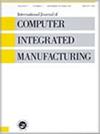基于数字孪生的搅拌摩擦焊温度监测系统
IF 3.7
3区 工程技术
Q2 COMPUTER SCIENCE, INTERDISCIPLINARY APPLICATIONS
International Journal of Computer Integrated Manufacturing
Pub Date : 2023-11-05
DOI:10.1080/0951192x.2023.2278113
引用次数: 0
摘要
摘要搅拌摩擦焊的温度场分布直接影响焊接质量,因此对焊接温度的实时监测具有重要意义。然而,由于机械障碍、材料塑性变形和复杂的热-力耦合,对核心区的温度监测存在困难。为了解决这一问题,本研究开发了一种基于数字孪生的FSW温度监测系统。首先,提出了一个基于数字孪生概念的五维集成框架,概述了基于数字孪生的FSW温度监测系统的构建过程。随后,建立了FSW的运动仿真模型,实现了焊接过程的同步运动仿真。FSW工件表面的实时温度读数通过红外热成像仪收集,并通过插座通信同步传输到FSW温度监测系统。此外,采用支持向量回归(SVR)的预测模型,可以实时精确地预测核心区的极端温度和超限报警功能。最后,以数字孪生概念为基础,结合所提出的模型和特征,开发了FSW温度监测系统,并进行了实验验证。该系统使操作人员能够及时控制焊接过程,以确保焊接质量。本研究得到国家重点研发计划项目(No. 2019YFA0709003)和辽宁省自然科学基金项目(No. 2023-MS-101)的支持。对财政捐助表示感谢。披露声明作者未报告潜在的利益冲突。基金资助:国家重点研发计划[2019YFA0709003];辽宁省自然科学基金[2023-MS-101]。本文章由计算机程序翻译,如有差异,请以英文原文为准。
Temperature monitoring system of friction stir welding based on digital twin
ABSTRACTTemperature field distribution of friction stir welding (FSW) influences weld quality directly, so real-time monitoring of the welding temperature is significant. However, it is difficult to monitor the temperature in the core zone due to mechanical obstructions, material plastic deformation and complex thermal-mechanical coupling. To tackle this issue, this study develops a digital twin-based temperature monitoring system of FSW. Initially, a five-dimensional integrated framework based on the digital twin concept is proposed, outlining the process of building a digital twin-based temperature monitoring system of FSW. Subsequently, a motion simulation model of FSW is established, and synchronous motion simulation of the welding process is achieved. Real-time temperature readings from the FSW workpiece surface are gathered via an infrared thermal imager and synchronously transmitted to the FSW temperature monitoring system using socket communication. Additionally, a predictive model utilizing Support Vector Regression (SVR) is incorporated, enabling real-time and precise prediction of extremum temperatures in the core zone and over-limit alarm functionality. Finally, the temperature monitoring system of FSW, grounded in the digital twin concept and integrating the outlined models and features, is developed and experimentally validated. The system enables operators to exercise timely control over the welding process to ensure weld quality.KEYWORDS: Friction stir weldingmonitoring systemtemperaturedigital twin AcknowledgmentsThe research was supported by the National Key Research and Development Program of China (Grant No. 2019YFA0709003) and Natural Science Foundation of Liaoning Province of China (2023-MS-101). The financial contributions are gratefully acknowledged.Disclosure statementNo potential conflict of interest was reported by the author(s).Additional informationFundingThe work was supported by the National Key Research and Development Program of China [2019YFA0709003]; Natural Science Foundation of Liaoning Province of China [2023-MS-101].
求助全文
通过发布文献求助,成功后即可免费获取论文全文。
去求助
来源期刊
CiteScore
9.00
自引率
9.80%
发文量
73
审稿时长
10 months
期刊介绍:
International Journal of Computer Integrated Manufacturing (IJCIM) reports new research in theory and applications of computer integrated manufacturing. The scope spans mechanical and manufacturing engineering, software and computer engineering as well as automation and control engineering with a particular focus on today’s data driven manufacturing. Terms such as industry 4.0, intelligent manufacturing, digital manufacturing and cyber-physical manufacturing systems are now used to identify the area of knowledge that IJCIM has supported and shaped in its history of more than 30 years.
IJCIM continues to grow and has become a key forum for academics and industrial researchers to exchange information and ideas. In response to this interest, IJCIM is now published monthly, enabling the editors to target topical special issues; topics as diverse as digital twins, transdisciplinary engineering, cloud manufacturing, deep learning for manufacturing, service-oriented architectures, dematerialized manufacturing systems, wireless manufacturing and digital enterprise technologies to name a few.

 求助内容:
求助内容: 应助结果提醒方式:
应助结果提醒方式:


